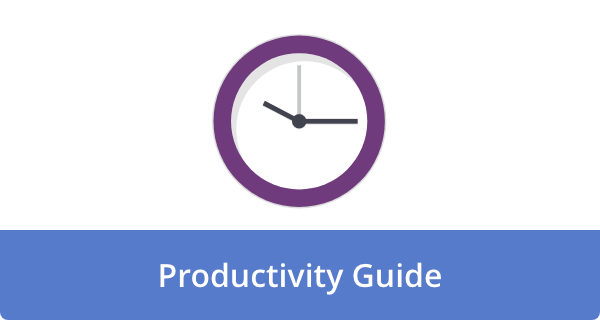

Do you find that your calendar is filled with endless meetings, deadlines, and back-to-back commitments? It’s not just you. In our hyper-connected, always-on world, many people instinctively fill their days with work, only to find themselves overwhelmed, disorganized, and constantly behind schedule.
Sixty percent of U.S. adults reported feeling too busy to enjoy life at times, according to a 2018 Pew Research Center survey. Moreover, employees spend 4.2 hours each week managing their calendars, according to a 2025 survey of over 10,000 Microsoft Outlook users by Reclaim.ai.
The solution? White space.
White space, also known as buffer time, breathing room, or margin, is the time between meetings, tasks, and commitments. Rather than just surviving, it is the mental and emotional oxygen your day needs to function at its best.
This post will explain why white space is not just a luxury but an essential element of a healthy and productive life. It will also discuss how to incorporate it into your calendar in a practical way and how it helps you accomplish more.
What Is White Space — And Why Does It Matter So Much?
A white space is similar to a book’s margins. The text would feel chaotic, overwhelming, and difficult to absorb if it extended to the edge of each page without any breaks or borders. Your daily schedule is no different.
The benefits of white space include;
- Time to think, reflect, and process. It’s hard for your brain to consolidate information or shift gears without taking breaks.
- Room for unexpected events or delays. It’s rare for life to follow a perfect schedule. Having white space, though, helps you absorb curveballs without getting thrown off track.
- Mental reset between high-focus tasks. Without breaks, jumping from one intense task to another diminishes your cognitive ability.
- Freedom to be creative, strategic, or simply pause. There are moments when breakthrough ideas emerge, or when you can recharge without guilt.
In a day packed to the brim, even a slight hiccup can cause chaos. For example, an urgent phone call or a meeting running five minutes late can cause immediate stress and throw off your entire meticulously planned day. However, this can be prevented by using white space, which gives you flexibility and resilience.
The Hidden Costs of a Packed Calendar
Many people instinctively resist adding white space to their schedules because they believe that working more hours equals getting more done. They fear that unscheduled time will result in them achieving less or being unproductive. In reality, cramming your schedule can lead to lower productivity and many other detrimental effects because of the following;
Decision fatigue.
As with any muscle, your brain gets tired. If you don’t take adequate breaks, your cognitive reserves deplete more quickly, making it harder for you to stay focused, resist distractions, and make informed decisions throughout the day. As a result, we make poorer choices and waste energy.
Reduced creativity and innovation.
Continuous task-switching and relentless mental overload stifle creative thinking and complex problem-solving. Most breakthrough ideas occur when you’re quiet and contemplating; they usually emerge in moments of calm reflection.
Burnout and disengagement.
Non-stop, high-pressure schedules increase the risk of professional and personal burnout. Eventually, chronic stress can lead to emotional exhaustion, cynicism, and reduced personal accomplishment, as well as physical health issues such as insomnia, anxiety, and chronic fatigue.
Reactive mode instead of proactive strategy.
If you’re booked solid, you’re always reacting to the urgent rather than focusing on the important. In turn, there are fewer opportunities to step back and think strategically, to consider the future, or to identify opportunities before they become crises.
Lower quality of work.
Whenever you’re rushed, your output will inevitably suffer. As a result, you make more mistakes, miss details, and produce merely “good enough” work instead of exceptional work. In the short term, quantity may rise, but quality will decline.
In general, white space reverses these detrimental effects, creating a sustainable rhythm that keeps you focused, calm, and highly effective. Rather than reacting, it allows you to act with intention.
How to Add White Space to Your Calendar (Step by Step)
Are you ready to give yourself more breathing room and reclaim your day? Here’s a step-by-step guide to getting started;
Step 1: Audit your current calendar.
To add white space, you must first determine where it’s most needed. Ask yourself the following questions about your calendar for the last two weeks (or even the past month):
- Is there a time when I felt most rushed, overwhelmed, or stressed?
- How did small delays or unexpected interruptions affect my entire schedule?
- What task was I unable to complete because I was too busy or distracted by upcoming commitments?
- Which times of day consistently felt chaotic?
During this quick audit, you’ll be able to identify patterns and pain points and discover where white space can help.
Step 2: Start small — add microbuffers.
It’s not necessary to block off entire afternoons right away. To begin, add small chunks of buffer time that are manageable. It’s surprising how powerful these micro-breaks can be:
- 5–10 minutes between meetings. By standing up, stretching, grabbing water, and reviewing notes from the previous meeting, you can mentally prepare for the next one.
- 15 minutes after highly focused tasks. Don’t jump into something new right after an intensive period of deep work.
- A 10-minute stretch in the afternoon to regroup. To clear your mind, consider taking a quick stroll, meditating, or simply gazing out the window.
As a result of these micro-breaks, your brain is reset, your cognitive fatigue is reduced, and you’re better prepared for what’s next without feeling perpetually behind.
Step 3: Block out strategic white space.
Adding larger blocks of unscheduled time to your calendar is the next step beyond micro-buffers. During these periods, you can do proactive work, reflect, or think unstructured.
- Morning planning time (20–30 minutes). Use this time to review your top priorities, set intentions, and organize your day before diving into emails.
- Midday white space (30–60 minutes). There’s more to this than just lunch. Disconnect, think, exercise, or go for a walk.
- End-of-day review (15–20 minutes). During this time, you can tidy up loose ends, plan for tomorrow, and cleanly transition out of work mode.
You should treat these blocks as non-negotiable appointments with yourself. If necessary, mark them as “Focus Time” or “Strategic Planning,” and avoid filling them with busywork unless absolutely necessary.
Step 4: Implement the “time cushion” rule for all commitments.
To ensure that you don’t run out of time, add a 15%–30% buffer to every primary task, meeting, or project. As a result, this can prevent chronic overbooking.
For example;
- Set aside 75-90 minutes if a project typically takes an hour.
- Whenever you have three consecutive calls, insert a 10-minute buffer between them.
- Schedule an hour for a task that will take 45 minutes.
This “time cushion” allows for interruptions, unexpected complications, and the human tendency to underestimate task duration. With time, this practice prevents chronic overbooking that causes stress, rushed work, and missed deadlines.
Step 5: Batch and theme your work.
When similar tasks are grouped together, also known as batching, context switching is minimized, and a larger swath of time is available for white space. Using this strategy, you can plan out your day and make it less fragmented. Examples include;
- Mornings for deep work. During these hours, you can devote your energy to complex tasks such as writing, analyzing data, or strategizing.
- Afternoons for meetings and collaboration. Put a specific time on your calendar for all your meetings and collaborative discussions.
- Fridays are for admin and planning. Spend one day (or half day) catching up on administrative tasks, answering emails, and planning for the future.
By alternating task types naturally, the rhythm reduces mental fatigue and improves efficiency.
Step 6: Communicate and defend your boundaries.
Whether it’s bosses, clients, or teammates, it’s essential to communicate your new approach and defend your white space if others often drive your calendar.
As such, here are some phrases and actions you can try:
- Your shared calendar should display “Focus Time” or “Deep Work” so others know you’re unavailable.
- Refuse unnecessary meetings or ask if you can contribute asynchronously. For instance, “Is it possible for me to provide my input via email instead?”
- Whenever meeting times are offered that conflict with your white space, suggest an alternative time slot, such as “I’m unavailable then, but I have openings at [X time] or [Y time].”
- If possible, set up “office hours” for responses.
By setting boundaries, you are not being uncooperative; you are optimizing your availability to deliver better work when you are engaged.
Step 7: Use technology smartly (not constantly).
You can support your white space goals by leveraging your calendar and productivity tools. With features like automatic meeting buffers, recurring “no meeting” blocks, or focus mode settings, you can reinforce your new habits.
It’s essential, however, not to let technology add a sense of urgency to every minute. Instead, use it to create intentional space, rather than scheduling everything constantly.
Step 8: Embrace the power of “no.”
Boundaries are important, but they deserve their own attention. If you want to create white space in your life, you must learn to say “no” to new commitments (or “not right now,” or “yes, but…”). Every “yes” means “no” to the white space you’re working to create, as well as to your well-being.
In short, you should be discerning about what you commit to.
Step 9: Practice mindful pauses.
There’s more to white space than blocks on a calendar; it’s also about pausing mindfully throughout the day. For example, before opening a new email, take a few deep breaths. Or, whenever you have a challenging conversation, try closing your eyes for 30 seconds. And, try to take 2 minutes out of your day to look out the window from your desk simply.
In addition to keeping you grounded, micro-pauses help prevent stress from accumulating.
Step 10: Schedule your personal life first.
Schedule your non-negotiable personal commitments before you fill your work calendar. These include exercise, family time, hobbies, appointments, and even dedicated downtime. By making these elements part of your calendar first, you’re less likely to sacrifice them when work demands arise, making your white space more powerful for holistic, balanced living.
Step 11: Regularly review and adjust.
Adding white space isn’t a one-time solution; it is an ongoing process. Review your calendar and assess your feelings about the issues that are occurring regularly (e.g., weekly or monthly). Are your buffers protected? Do they fulfill their purpose? Are there any new areas where you’re feeling overwhelmed? As your workload, energy levels, and life circumstances change, adjust your strategy accordingly.
The Benefits You’ll Start to Notice
By consistently building in white space, you will likely notice profound changes in your work and well-being:
- Less daily stress and frantic rushing. Having more control and feeling calmer will make you feel more at ease.
- Improved focus and attention. You will be able to concentrate better on your tasks.
- More creativity and big-picture thinking. It will be easier to come up with new ideas and solutions.
- Better energy throughout the day. You’ll feel more energetic and less sluggish in the afternoon.
- Higher quality output — not just higher quantity. You will be able to produce work that is more thoughtful and impactful.
Most importantly, you’ll feel in control again, rather than constantly chasing the clock. As a consequence, your schedule will become your architect instead of a victim.
Final Thoughts: Less Is Often More
In a culture where busyness is often praised, allowing gaps in your calendar can seem strange or even counterintuitive. There might also be a concern that you will appear unproductive or uncommitted. Over time, however, white space can reap several benefits.
White space is not wasted time. It’s the key to actual productivity and sustainability.
Rather than being surrounded by chaos, it allows you to breathe, think, create, and respond to life with clarity. It’s an investment in your mental health, your strategic capability, and your overall quality of life.
FAQs
What exactly is “white space” on a calendar?
The term “white space” refers to unscheduled blocks of time in your day. In other words, it’s the opposite of a jam-packed schedule. You can use white space for reflection, deep thinking, spontaneous creativity, or simply to catch your breath.
Why is adding white space so important for productivity and well-being?
Adding white space is crucial for several reasons;
- Decision fatigue
- Shallow work (switching tasks without real focus)
- Prevents burnout
- Reduced creativity and problem-solving
White space allows your mind to reset. By doing so, you’ll be able to think before you react, make better decisions, and generate new ideas. Those who are most successful in life prioritize large blocks of unstructured time for deep thinking.
How can I realistically create white space when my calendar is already packed?
With strategic planning, you can overcome this challenge.
- Be ruthless with declining. Get comfortable saying “no” to meetings that do not align with your priorities.
- Batch similar tasks. To reduce context switching and free up time, group similar activities together.
- Schedule “focus time.” Schedule specific times for deep work and keep them unmovable.
- Build in transition time. Avoid scheduling meetings back-to-back. Between appointments, allow 15-30 minutes for breaks and mental shifts.
- Utilize tools. By setting default meeting lengths that include buffer time or blocking recurring “white space” appointments, you can control how much time is spent in meetings.
What are some practical ways to use the white space I’ve created?
White space is versatile, and that’s what makes it so appealing. It can be used for;
- Deep work. Work on complex projects that require sustained focus.
- Strategic thinking/planning. Review your goals, priorities, and long-term vision from a step back.
- Creative brainstorming. Let your mind wander and generate new ideas.
- Catch-up or admin tasks. Tackle small, nagging tasks that can otherwise accumulate.
- Professional development. Get to know your industry by reading articles, taking an online course, or listening to a podcast.
- Recharge and self-care. You can take a walk, meditate, drink coffee, or simply do nothing.
How Can I Stick With It When Life Gets Busy?
Protecting your white space requires consistency and boundaries, just as with any new habit. Here are some tips to help you;
- Treat it as non-negotiable. Avoid canceling or rescheduling white spaces unless necessary.
Communicate. If you want your team or family to respect those windows, inform them about your white space practice. - Start small. A 15-minute block every day is a win. From there, build up.
- Review weekly. Whenever you reach the end of each week, ask yourself: Have I left myself enough breathing room? What impact did it have on my stress, focus, and energy levels?
In time, you’ll probably find that limiting white space makes you more productive and peaceful.
Image Credit: Tara Winstead; Pexels











John Hall
John Hall is the co-founder of Calendar a scheduling and time management app. He’s also a keynote speaker that you can book at http://www.johnhallspeaking.com.